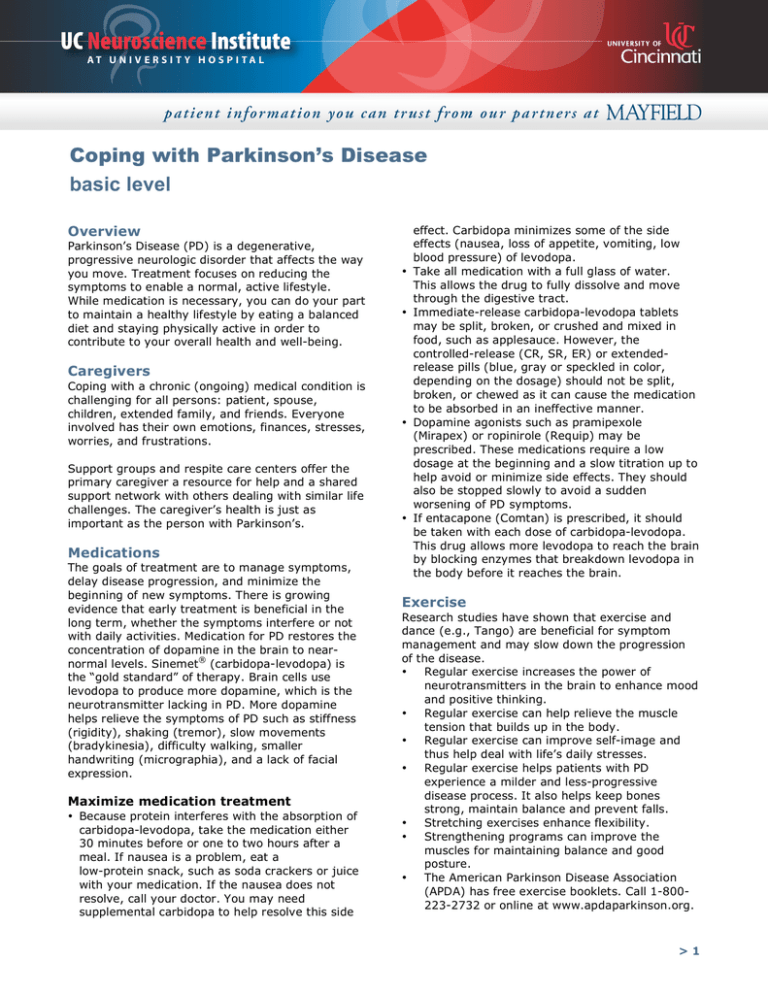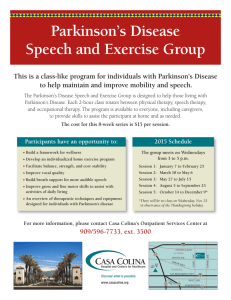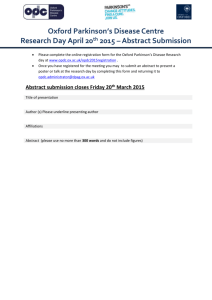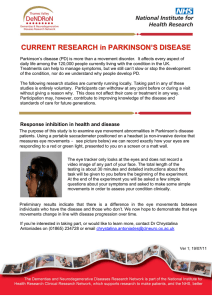
Coping with Parkinson’s Disease
basic level
Overview
Parkinson’s Disease (PD) is a degenerative,
progressive neurologic disorder that affects the way
you move. Treatment focuses on reducing the
symptoms to enable a normal, active lifestyle.
While medication is necessary, you can do your part
to maintain a healthy lifestyle by eating a balanced
diet and staying physically active in order to
contribute to your overall health and well-being.
•
•
Caregivers
Coping with a chronic (ongoing) medical condition is
challenging for all persons: patient, spouse,
children, extended family, and friends. Everyone
involved has their own emotions, finances, stresses,
worries, and frustrations.
Support groups and respite care centers offer the
primary caregiver a resource for help and a shared
support network with others dealing with similar life
challenges. The caregiver’s health is just as
important as the person with Parkinson’s.
Medications
The goals of treatment are to manage symptoms,
delay disease progression, and minimize the
beginning of new symptoms. There is growing
evidence that early treatment is beneficial in the
long term, whether the symptoms interfere or not
with daily activities. Medication for PD restores the
concentration of dopamine in the brain to nearnormal levels. Sinemet® (carbidopa-levodopa) is
the “gold standard” of therapy. Brain cells use
levodopa to produce more dopamine, which is the
neurotransmitter lacking in PD. More dopamine
helps relieve the symptoms of PD such as stiffness
(rigidity), shaking (tremor), slow movements
(bradykinesia), difficulty walking, smaller
handwriting (micrographia), and a lack of facial
expression.
Maximize medication treatment
• Because protein interferes with the absorption of
carbidopa-levodopa, take the medication either
30 minutes before or one to two hours after a
meal. If nausea is a problem, eat a
low-protein snack, such as soda crackers or juice
with your medication. If the nausea does not
resolve, call your doctor. You may need
supplemental carbidopa to help resolve this side
•
•
effect. Carbidopa minimizes some of the side
effects (nausea, loss of appetite, vomiting, low
blood pressure) of levodopa.
Take all medication with a full glass of water.
This allows the drug to fully dissolve and move
through the digestive tract.
Immediate-release carbidopa-levodopa tablets
may be split, broken, or crushed and mixed in
food, such as applesauce. However, the
controlled-release (CR, SR, ER) or extendedrelease pills (blue, gray or speckled in color,
depending on the dosage) should not be split,
broken, or chewed as it can cause the medication
to be absorbed in an ineffective manner.
Dopamine agonists such as pramipexole
(Mirapex) or ropinirole (Requip) may be
prescribed. These medications require a low
dosage at the beginning and a slow titration up to
help avoid or minimize side effects. They should
also be stopped slowly to avoid a sudden
worsening of PD symptoms.
If entacapone (Comtan) is prescribed, it should
be taken with each dose of carbidopa-levodopa.
This drug allows more levodopa to reach the brain
by blocking enzymes that breakdown levodopa in
the body before it reaches the brain.
Exercise
Research studies have shown that exercise and
dance (e.g., Tango) are beneficial for symptom
management and may slow down the progression
of the disease.
•
Regular exercise increases the power of
neurotransmitters in the brain to enhance mood
and positive thinking.
•
Regular exercise can help relieve the muscle
tension that builds up in the body.
•
Regular exercise can improve self-image and
thus help deal with life’s daily stresses.
•
Regular exercise helps patients with PD
experience a milder and less-progressive
disease process. It also helps keep bones
strong, maintain balance and prevent falls.
•
Stretching exercises enhance flexibility.
•
Strengthening programs can improve the
muscles for maintaining balance and good
posture.
•
The American Parkinson Disease Association
(APDA) has free exercise booklets. Call 1-800223-2732 or online at www.apdaparkinson.org.
>1
•
The Parkinson’s Disease Foundation (PDF) has
two programs available in video or DVD format.
Call 1-800-457-6676 or online at www.pdf.org.
Diet and nutrition
According to the National Institute of Aging, the
element most absent from the diets of Americans is
nutrition, foods that provide the proteins,
carbohydrates, vitamins, minerals, hydration, fiber,
and fats that allow the body to operate at it’s best.
PD medications and symptoms can sometimes
reduce the pleasure of eating, so it is important to
make the best food and nutrition choices to
maintain optimal health as the disease progresses.
•
See a nutritionist or dietician to help adapt your
needs to your lifestyle. They can build a food
plan that fits your likes and dislikes.
•
Review the food pyramid recommended by the
U.S. Department of Agriculture at
www.mypyramid.gov.
•
Water is the most important fluid to drink,
flavor it with lemon or fruit juice if you don’t
like it straight. Drink six to eight glasses a day.
•
Fiber (whole grain breads, brown rice, green
leafy vegetables, nuts) is critical to help with
prevention of constipation problems and
provide natural sources of vitamin E, which may
have a protective effect against PD.
•
Calcium, magnesium, and vitamins D and K are
bone-strengthening nutrients found in dairy
products.
Activities of daily living
There are many things a person does every day
without even thinking about it such as bathing,
brushing teeth, walking, turning in bed, signing
checks, cutting food. When a person is diagnosed
with Parkinson’s, it can eventually make all of these
things more difficult. The following tips are meant
to be helpful and raise awareness of adjusting to
some of the difficulties with PD.
Falling
• Remove throw rugs and low-lying obstacles from
pathways inside and outside your home.
• Use a cane when necessary.
• Avoid using stepladders or stools to reach high
objects.
• Stop walking or sit down if you feel dizzy.
• Install handrails, especially along stairways.
• Slow down when you feel yourself in a hurry.
• Before rising from your bed or bath, pause for a
moment in a sitting position.
Sensory complaints
• Stretch every day, especially before exercising.
• Exercise daily to build stamina.
• Warm baths and regular massage will help relax
tired muscles.
• When your hands or feet get cold, wear gloves
or warm socks.
• Don't overdo physical activities; know your limits
and stay within them.
Turning in bed
• Install nightlights.
• Install light switches where you can reach them
easily while in bed.
• When turning to one side, first turn your head,
then push off with the opposite foot and rotate
your hips. As soon as your hips start to move,
reach with your uppermost arm in the same
direction.
• When you want to sit up, lie on your side facing
out, near the edge of the bed. Place both hands
flat on the bed in front of your chest. Push down
with your hands, and swing your legs over the
edge.
• To get out of bed, first sit up on the edge of the
bed, put both feet on the floor, place your hands
next to your hips, and push off slowly.
• Satin bed sheets or satin pajamas reduce friction
and make movement easier.
Sleep problems
• Depression can cause insomnia. Tell your doctor
about sleep problems and feelings of sadness.
• Watch for breathing difficulty during sleep. Sleep
apnea can be associated with PD.
• Restless leg syndrome is a common off symptom
in PD that can cause sleep problems.
• Excessive daytime sleepiness can be caused by
dopamine agonists or other PD medications.
Avoid alcohol, caffeine and fluid intake at night.
Avoid daytime naps and try to re-establish a
normal sleep-wake cycle.
• Tell your doctor about motor activity during
dreams (striking out, yelling). This can be seen
in PD, can disrupt sleep, and can be easily
treated.
Dressing
• Replace clothes that have complicated fasteners
with ones you can slip on easily, such as
sweatpants, sweatshirts, or pants with elastic
waistbands.
• Avoid clothes that fasten in the back.
• Look for clothes and shoes with Velcro fasteners,
or have the buttons and zippers on your clothes
replaced with Velcro.
• Consult your medical supply store or a catalog for
dressing aids, such as dressing sticks and
long-handled shoehorns.
• Make your dressing area "user friendly." Install
clothes rods and drawers that make your clothing
easy to reach.
• Dress sitting down on a bed or a chair. Place the
clothes you plan to wear next to you on the bed
or on a table within easy reach.
• Always wear shoes or slippers.
• Put clothes on and take clothes off from your
stiffer side first.
>2
Hygiene
• "Accident-proof" your bathroom. Replace glass
partitions and slippery bath mats, and use paper
cups.
• Tile flooring in the bathroom can become slippery
and dangerous when wet. Consider replacing it
with wall-to-wall carpeting.
• Install sturdy grab bars next to the bath, toilet,
and wherever else you need balance and support.
Never use towel racks for support.
• Avoid standing up in the bathtub. If you like to
take showers, consider sitting down in the shower
or place rubber mats on the floor of the tub.
• Instead of drying with a towel after you bathe,
put on a terry-cloth robe.
• Use an electric toothbrush. Ask your dentist for
recommendations.
Walking
• If you notice yourself shuffling, slow down or stop
walking and check your posture.
• Keep your feet a comfortable distance apart,
eight to ten inches.
• Stand up straight with your head over your hips.
• Buy a good pair of walking shoes with a low heel
and good arch support. Avoid running shoes or
shoes with crepe soles.
• Exaggerate lifting your feet and swinging your
arms. With each step, pretend you are stepping
over a log.
• Practice taking long steps.
• When you need to turn around, don't pivot on one
foot. Instead, walk around in a circle until you're
facing the direction you want to go.
Swallowing
• Take extra-small bites of food, chew thoroughly,
and swallow carefully.
• Chop up your food in a food processor, so that it's
easier to chew and swallow.
• Always swallow your food completely before
taking more food into your mouth.
• Use an electric warming tray to keep your food
hot so that you won't feel the need to rush.
• Family members and caregivers should consider
receiving training in the Heimlich maneuver.
• Swallow excess saliva before you put food into
your mouth.
• Keep a beverage at hand during meals and take
frequent sips.
Freezing
• When you freeze, stop trying to walk; instead,
press your heels to the floor.
• Look straight ahead, not down.
• Pick a target and walk toward it, especially when
walking through doorways.
• If you're walking with someone, have the person
hold your arm or elbow.
• Develop a regular stretching and exercise
program. Regular movement can help you
maintain your sense of balance and posture.
• Stand up straight, with your head over your hips,
but don't lean backwards.
Tremor
• Perform difficult tasks when you feel well and
when your medication is working effectively.
• Relax. Sit down from time to time, relax your
arms and shoulders, and take deep breaths.
• Get a regular massage.
• Ask your physical therapist or doctor to
recommend a stretching and exercise program.
• Avoid caffeine and alcohol.
• Get plenty of rest.
Salivation
• To control saliva accumulation, you must swallow.
Swallowing may no longer be an automatic reflex.
You may have to force yourself to remember to
swallow.
• Chew gum or suck on a piece of hard candy.
• Try sleeping on your side, so that you won't wake
up choking during the night.
• Swallow excess saliva before you put food into
your mouth.
• Keep a beverage near you during the day. Get in
the habit of frequently taking small sips.
Cutting food
• Use "non-skid" or rubber place mats that will help
you keep your plates and serving dishes from
sliding.
• Eat foods that do not require cutting with a knife.
• Use a food processor to chop or shred your food
after it is cooked.
• Ask someone to cut your food for you.
• Use large-handled utensils that are easy to grip.
• If you own specially adapted utensils, carry them
with you whenever you plan to eat out.
• Use flexible straws to prevent spills.
Speech
• Take a breath before you start to speak, and
pause between every few words or even between
each word.
• Exaggerate your pronunciation. Pretend that
your listener is hard of hearing and needs to
read your lips.
• Face your listener directly when speaking.
• Finish saying the final consonant of a word
before starting to say the next word.
• Express your ideas in short, concise phrases
or sentences.
• Exaggerate facial motions as you practice reciting
the alphabet, counting numbers, or reading a
magazine or newspaper out loud.
• Encourage your family and friends to ask you to
speak louder or repeat yourself if they can't
understand what you're saying.
• Speak for yourself, and speak often. Don't get in
the habit of letting others speak for you.
>3
Handwriting
• Try using a large-body pen or pencil or one with a
build-up handle.
• Experiment with different types of pens. Felt-tip
pens, for example, have a "slippery" feel that
offers less resistance.
• Lift your arm up from time to time, straighten
your elbow, and move your fingers.
• Instead of writing by hand, use a typewriter or
word processor. If you don't have keyboard skills,
practice a little every day. The exercise will help
improve your dexterity.
• If someone is available to type for you, use
a Dictaphone.
• Consider corresponding by recording your
messages on tape.
Taking care of business
The National Parkinson Foundation has developed
a thorough guide to getting your household and
personal documents organized at
www.parkinson.org
•
•
•
•
•
Organize your medical histories
Keep a journal of medications and dosages
Organize your personal financial documents
Insurance and long-term care plans
Livings wills, durable power of attorney,
advanced medical directives
Sources & links
If you have any questions, please call the Mayfield
Clinic at 800-325-7787 or contact the Gardner
Center for Parkinson’s Disease & Movement
Disorders at the University of Cincinnati (UC)
Neuroscience Institute at 513-475-8730.
Support
Patients and their families can contact local support
groups in Ohio, Kentucky, Indiana and Michigan
through the Tristate Parkinson’s Wellness Chapter
at 513-948-1100 or 877-489-1110. A support
group provides an opportunity for patients and their
families to share experiences, receive support, and
learn about advances in treatments, and
medications.
Links
Tristate Parkinson’s Wellness Chapter
www.parkinsonswellness.org
Parkinson's Disease Foundation
www.pdf.org
The National Parkinson Foundation
www.parkinson.org
American Parkinson Disease Association
www.apdaparkinson.com
CARE: Caregivers Are Really Essential
www.pdcaregiver.org
Parkinson's Training for Caregivers
www.parkinsonseducator.com
updated > 9.2009
reviewed by > Maureen Gartner, RN, M.Ed., Andrew
Duker, MD, Alberto Espay, MD
Mayfield Clinic is the neurosurgery partner for the UC Neuroscience Institute,
and provides this content as a service to our patients. This information is not
intended to replace the medical advice of your health care provider. For more
information about our editorial policy and disclaimer, visit our Web site
www.MayfieldClinic.com or write to Tom Rosenberger, Vice President
Communications.
© Mayfield Clinic 2009. All rights reserved.
506 Oak Street • Cincinnati, OH 45219
513.221.1100 • 800.325.7787
>4
EDUCATIONAL RESOURCES
1. AMERICAN PARKINSON DISEASE ASSOCIATION , INC
Conducts patient care and research activities related to this neurological disorder. Includes
resources about the disease, events, and programs. Click on Young Parkinson’s for The Arlette
Johnson Young Parkinson Information and Referral Center; also click on Local Information and
Referral Center on the home page to locate a support group or chapter.
http://www.parkinsonsdisease.com/ PH: 1-800-223-2732
2. THE BACHMANN-STRAUSS DYSTONIA & PARKINSON FOUNDATION
This foundation focuses on research updates for dystonia and PD.
www.dystonia-parkinsons.org PH: 1-212-241-5614
3. THE MICHAEL J. FOX FOUNDATION
Sign up for the e-mail on the home page to receive the newsletter and regular e-mail updates on
research and other advances toward a cure.
www.michaeljfox.org PH: 1-800-708-7644
4. THE MUHAMMAD ALI PARKINSON CENTER
Besides being an excellent resource of education, the site offers a PD Registry to help gather data
on PD prevalence in the United States. Data collected from the registry will be used to facilitate
the development of new therapies and healthcare services. The goal is to improve the quality of
life for people with Parkinson’s at MAPC and at PD centers worldwide.
www.maprc.com PH: 1-602-406-4931
5. NATIONAL PARKINSON FOUNDATION
Find the latest news and developments in Parkinson’s disease research. Includes a list of
publications, events, and support groups.
http://www.parkinson.org/ PH: 1-800-327-4545
6. NUTRITION YOU CAN LIVE WITH
Registered dietician offers a book that focuses on the nutritional needs of people with
Parkinson’s disease. Includes ordering information.
www.nutritionucanlivewith.com
7. PARKINSON’S ACTION NETWORK
The Parkinson’s Action Network (PAN) is the unified voice of the Parkinson’s disease
community—advocating for more than one million Americans and their families. Click on
Become an Advocate and join the fight for a cure.
www.parkinsonsaction.org PH: 1-800-850-4726
8. PARKINSON’S DISEASE BOOK STORE
Books and resources specifically for individuals with Parkinson’s disease and their caregivers.
www.wellnessbooks.com
RESOURCES FOR CAREGIVERS
9. CARE: CAREGIVERS ARE REALLY ESSENTIAL
A website which offers the CareGiver practical ideas to cope with all of the experiences of PD.
www.pdcaregiver.org
10. COUNCIL ON AGING OF SOUTHWEST OHIO
A community resource guide to access local services
www.help4seniors.org
11. NATIONAL ALLIANCE FOR CAREGIVING
The National Alliance for Caregiving is dedicated to providing support to family caregivers and
the professionals who help them and to increasing public awareness of issues facing family
caregivers.
www.caregiving.org
12. NATIONAL FAMILY CAREGIVERS ASSOCIATION
The National Family Caregivers Association educates, supports, empowers and speaks up for the
more than 50 million Americans who care for loved ones with a chronic illness or disability or
the frailties of old age. NFCA reaches across the boundaries of diagnoses, relationships and life
stages to help transform family caregivers' lives by removing barriers to health and well being.
www.nfcacares.org
13. NORTHERN KENTUCKY AGING SERVICES
A community resource guide for northern Kentucky
www.nkadd.org
14. PARKINSON’S TRAINING FOR CAREGIVERS
A free online course developed to train caregivers in caring for those with Parkinson's
Disease in long-term care settings.
www.parkinsonseducator.com
15. PARKINSON FOUNDATION OF THE HEARTLAND
The Parkinson Foundation of the Heartland is a non-profit organization dedicated to finding the
cure for Parkinson's Disease and to providing services and educational programs for people with
Parkinson's and their caregivers.
www.parkinsonheartland.org





